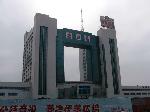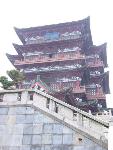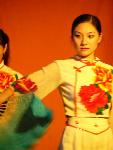- Getting around Lijiang. Dont stay in the Old Towns more than 2 days, there is nothing to do. KRISS Oct 9, 2013 05:46
- 2013 Beijing Temple Fair BENNYLAU Feb 26, 2013 03:29
- Malaysian traveling from KUL - LAX vis Shanghai PVG ZATI_DY Jan 3, 2013 20:15
Luo Xia Yu Gu Wu Qi Fei
- Views: 8119
- |Vote: 0 0
- |Add to Favorites
- |Recommend to Friends
Southbound Train
Perhaps it was a silly idea from the start - leaving Beijing just as the stifling sumer heat was subsiding and heading off for Southern China, which was still frying under the sun. I'm useless on a sweaty day and find the sticky summers quite unbearable - but I'm still never reluctant to step on something that moves, especially when it's heading somewhere I've never been before. The whole of Jiangxi Province has always been out of reach for me in the four years I've spent in China - for some reason, I've always circumvented the place in my travels - and this was as good an opportunity as any to correct the problem on my way to the southern Chinese border - and spend a night or two in the city of Nanchang.
I booked a bunk on the overnight to Nanchang, and was surprised at how easy it was to buy tickets - September seems to be a good time to travel. A month later and China hits another 'golden travel week', utter hell for real travellers who will find it near impossible to get tickets for anything they can lie down on. My train pulled out of the Beijing West railway Station on a warm afternoon and began its gradual descent into the boiling south.
I have to admit, we 'taking it rough' China travellers are about as pampered as it can get these days. Just twenty years ago, travellers who wanted to get away from the luxury-seekers and discover some of the real China would have had to suffer 40 hour train trips with standing tickets, no air conditioning and no relief - it's no wonder they came back treasuring the things they'd been able to see - it had been so hard to get there. By contrast, an RMB240 ticket had bought me a cool nook in a carriage of 60 passengers, with a soft blanket and the option to sleep as late as I wished. If only the railway officials enforced the non-smoking policy in the carriages, I'd have been just as comfortable as I would have been say, sleeping on the couch in my own apartment. If that's roughing it, I just do not know what's particularly rough about it.
In the morning the sun was indeed beating down as I entered Jiangxi, the province that is home to the mighty Gan river, which feeds China's largest freshwater lake, Poyang Hu. Jiangxi is a rural and quiet place that for reasons of poor accessibility has traditionally been less populated than neighbouring provinces. Nanchang is the provincial capital with a headcount of only around a million people, and has only really in recent times seen better fortunes and increasing development.
I arrived at Nanchang and immediately queued to buy my ongoing ticket - absolutely essential when travelling in China if you want the best chance of a good ticket - and found a very comfortable hotel opposite the station called the Planet - RMB150 got me a palatial room with fine glassed-in shower and writing desk. That's travelling rough.
Tengwang Ge
Nanchang's not a big draw for tourists - the city is bleak, to be quite frank, and the attractions are few and generally unimpressive. The one major drawcard for the city, however, is the ancient Teng Wang Pavillion, one of the three great towers south of the Yangtse river - the other two being the Yellow Crane tower in Wuhan, and the Yueyang tower in Yueyang, northern Hunan. I'd seen the other two before, and needed to complete the set - and besides, the Teng Wang tower is outstanding in its own right as a feat of Chinese architecture.
Visitors need to stretch their convictions somewhat when visiting this tower as to what constitutes 'ancient', because despite the fact that the Teng Wang tower is touted as being an 'ancient wonder', it was in fact only completed in 1989. The fact is that although the Teng Wang tower has been in existence since 653AD, when it was built for the son of the Tang Dynasty's first Emperor, it has since been destroyed and rebuilt no less than 28 times. This modern reconstruction may be physically new, but the tradition of recreating the tower, each time according to the style and fashion of the age, is something of a tradition - and the new Teng Wang pavillion is a valid and incontrovertible member of the succession.
Called the Teng Wang Ge - 'Ge' usually refers to a two-levelled building, although the Teng Wang Ge has nine - three visible from the outside and four hidden within, with two below - it stands on the east bank of the Gan River and architecturally reflects the style of the Song dynasty, with dark green tiles, sweeping flared eaves and a steeply sloping top roof. The nine layers are symbollic of the heavens, which according to Chinese legend has nine levels.
What makes this tower so special for the Chinese is that its reputation is carried in verse, most popularly by the James Dean of Tang Dynasty Chinese poets, Wang Bo. Wang Bo was an exceptional literary talent at a young age, and the story goes that one night he was invited to accompany his father - who was being appointed to an official post in North Vietnam, then considered Chinese territory, to a function at the tower. This must have been a big deal for the 25 year old bard, whose enthusiasm spills into his poetic record of the event - recording not only the lights and gentrified atmosphere of what was evidently an impressive affair at the tower, but also the poignant beauty of the sights and sounds on the way, something that has left a deep impression of the age for succeeding generations of Chinese. He famously recorded the flight of a lone duck up to the lowering clouds as the colours of the river and the sky shone in unison:
"luo xia yu gu wu qi fei / qiu shui gong chang tian yi se"
He died just a year later, but this poem continues to charm readers to this day and has become an inseperable part of the history of the tower. I was told that Chairman Mao was fond of quoting the lines mentioned above, and that his calligraphic rendering of these lines was copied onto the pillars in front of the doors of the current tower - the full text is inscribed within.
Visiting the Tower
Teng Wang Ge is every bit as impressive as its reputation suggests, and when I arrived at the gates I was more than willing to hand over the rather expensive RMB50 entrance fee to pass through the main gates and stand before it. Standing as it does above a stretch of dull grey city blocks and the silty waters of the Gan river, it was hard for me to generate quite the same awe as Wang Bo would have felt when approaching the tower on the same spot 1400 years before, but I was sufficiently impressed by the structure to spend a while staring at the shape of the building and appreciating the achievements of traditional Chinese architecture represented in this reinterpretation of the tower.
I'd read that the tower is filled with bland exhibits, but I found the opposite to be true - every one of the levels in the tower was filled with interesting museum pieces, artworks and displays. I was particularly impressed by the models of the previous incarnations of the tower - each one distinctive and equally impressive, all dating from different dynasties and with different design features. There were exhibits of ancient clothing, weaponry and ceramic art (Jiangxi's Jingdezhen prefecture is known as the country's best traditional producer of chinaware), amongst many others - and the treat of the whole museum was at the very top level where daily performances are held by the Teng Wang Ge Arts Troupe, with eight regular shows from 8.30 to 5.15 and a command perfromance at 7.00.
I arrived to see the dancers practicing and decided to wait out the half hour for the performance, because it was clearly going to be rather good. I couldn't help but notice that the girls dressed in traditional costume on stage strikingly reflected the artistic depictions of dancers of ancient times painted on the walls - I remembered again Wang Bo's wonderful night in the tower and wondered if he'd seen dancers such as these.
The gracious dancer in front moved sinuously with her fan, twirling to the rich sounds of the Chinese zither and struck gong. Her dark, almond-shaped eyes shone in the dim light, and her Mickey Mouse underwear showed plainly through her silky costume, which proved to be the draw for a group of army boys who were enjoying the spectacle immensely. I particularly enjoyed the instrumental ensemble, traditional instruments joined by a competent double-bass player - a performance that alone would have been worth the entrance price. At the top of the ancient Teng Wang pavillion, with a view over the sad stone blocks of modern Nanchang, I had found a moment of Chinese history that was both authentic and timeless.






 Copyright © 1998-2025 All rights reserved.
Copyright © 1998-2025 All rights reserved.
1.
Sep 13, 2006 00:25 Reply
MISHEN said:
Yes, poor girl! Always be careful when you're on stage... that being said it was an exceptional performance.
2.
Sep 12, 2006 08:23 Reply
CHYNAGYRL said:
i thought this was gonna be a straight forward piece until that part about the Mickey Mouse underwear. Poor girl :-(
3.
Sep 12, 2006 03:32 Reply
CALIFORNIA said:
So expensive!!!Not better than Forbidden City~~~
4.
Sep 11, 2006 05:02 Reply
MAY001 said:
I just passed away the Teng Wang Ge and took some photos. Don't even want to get in. No, it's not what I want. It's just a fake.